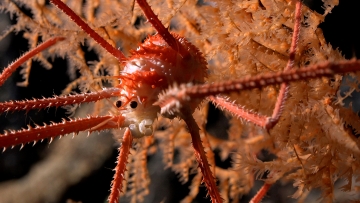SATS print 231_360 px width.jpg

Many new species, such as this squat lobster, were documented during recent explorations of seamounts off the coast of Peru and Chile. Credit: ROV SuBastian / Schmidt Ocean Institute, CC BY-NC-SA
With thousands of species of the world’s organisms yet to be discovered, it’s not unusual for scientists to discover several new ones on a lengthy oceanic expedition. But it’s far less common for a single expedition to discover more than 100 new species, as one group estimates it did earlier this year while exploring seamounts along the west coast of South America.
An expedition from the Schmidt Ocean Institute investigated the Nazca and Salas y Gómez Ridges in January. These are two underwater mountain ranges that stretch over 1,800 miles from the coasts of Peru and Chile out into the southeastern Pacific Ocean to Easter Island. The scientists used an underwater robot that could descend to 2.8 miles below the sea surface to collect data from ten of the seamounts. Each of those seamounts was home to its own unique ecosystem, consisting of dozens of species never before identified. The new species included various deep-sea corals, glass sponges, sea urchins, squat lobsters, amphipods, and more.
The team set out a second time in February on a 40-day expedition along the Salas y Gómez Ridge. This time they identified at least 50 more species they believe to be new to science and they found another 160 species that hadn’t previously been documented in that area before. They also discovered the deepest ever-recorded animal in the world to rely on the sun for energy, a wrinkle coral called Leptoseris. It will take several years to catalogue all the species and get a precise count of the new ones.


